CHAPTER III
1816, Continued JACOB RADCLIFFE MAYOR
BUT one theatre was open in the city, the Park, built in 1798, standing
at 23 Park Row, and running back to Theatre Alley, which extends from Ann
to Beekman Street. There was one smaller in Anthony Street, near Broadway,
which had been opened in 1814, but now was unoccupied, and later was the
site of Christ Church. Concerning further means of amusement, it may be
noted here that at this date bull and bearbaiting was practiced
as neither unlawful nor improper. The first theatre in New York was opened
in 1750 in Kip (Nassau) Street, between John Street and Maiden Lane. In
1761 a theatre was built on the lower side of Beekman Street, near Nassau,
in which during that year "Hamlet" was presented for the first
time in America. This house was wrecked during a riot over the Stamp Act
in 1765 In 1767 the John Street Theatre, on the north side near Broadway,
was opened; in 1776 the Montague Garden on Broadway between Chambers and
Barclay streets; and in 1785 two new theatres were opened, one in William
Street and one in lower Greenwich Street; doors open at 5.15, and curtain
raised at 6 P. M.
At the Park the hour of opening was halfpast six, the performance
beginning at halfpast seven. It was universally the custom to give
two pieces of performance, generally a tragedy and a comedy; and sometimes
three pieces were given, and between the pieces a comic song, a pas
seul or pas de deux by danseuses. The pit, now termed parquet,
was provided with board benches without cushions, and occupied exclusively
by men and boys; the boxes were enclosed in the rear, the entrance to them
through a locked door jealously guarded by a keeper. There was an advantage
in this which fully compensated any inconvenience attendant upon it, inasmuch
as the rear wall of the box reflected sounds from the stage; from which
cause, added to the circumstance that the interiors of the buildings were
less ornate than at a later day, the voices on the stage were much more
audible than with the open seats. This arrangement left a wide space for
lobby or foyer, in which it was customary for the male portion of the audience
during the acts to promenade. In the second tier there was a moderate restaurant,
and in the third tier a bar. In this theatre there was a very perfect whispering
gallery; the peculiar face and arching of the proscenium enabled a sound
delivered on one side in the third tier to be distinctly audible on the
opposite side. Upon this becoming known it was availed of by humorists,
to the dismay and annoyance of many who were ignorant of it. In the third
tier of theatres before this time, and for many years after, the class
of females erroneously termed demimonde were permitted to be present,
and on several occasions parties who had better have been absent, being
seated in the endbox, and near the arch, were dismayed at hearing
a voice near to them advising them to go home and attend to their families,
etc. Prior to the closing of the theatre for the summer recess, it was
the custom to set apart one night's performance, known as "ticket
night," for the benefit of the employees of the house.
Not a few citizens yet living find pleasure in reviving in their conversation
the glories of "the old Park." No doubt its scenery and appointments
were primitive, compared with the elaborate provision made for modern theatres,
as a result of the singular development of scenic art which has appeared
in recent years. Excepting only its spacious stage-forty by seventy feet-the
Park lacked nearly everything in the way of physical appliances that are
considered necessary inour theatres; but it is probably within reason
to maintain that in the quality of its acting and of its audiences it remains
unapproached, and that no theatre of the present period holds the primacy,
or even supremacy, which it enjoyed without challenge. Even the present
generation will understand this supremacy of a stage that witnessed-to
select only a few names from the stock company, and stars that shone at
intervals-the performances of Mrs. Wheatly, Mrs. Vernon (for many years
afterward at Wallack's, and still "freshly remembered"), Mrs.
Sefton, Miss Ellen Tree, Miss Fanny Kemble, Miss Charlotte Cushman, Miss
Emma Wheatly (Mrs. Mason), Miss Clara Fisher (Mrs. Maeder), Edmund and
Charles Kean, Charles Kemble, Junius Brutus Booth, Edwin Forrest, James
Wallack (father of John Lester Wallack), Harry and Tom Placide, George
Vandenhoff, William Wheatly, Tyrone Power, Cooke, Young, and Cooper. Mrs.
Wheatly, so long and so well known to this theatre, daughter of an officer
in the British Army, accomplished actress and universal favorite both on
and off the stage, made her first appearance at the Park in 1805. She retired
soon after, but reappeared in 1815, and continued her public career until
1848.
Kinlock Stuart, residing at 40 Barclay Street in 1800, and for some
years thereafter, failed in his business, and in 1807 his wife began, in
a very humble way, the manufacture of candies, preserves, etc., at 271
Greenwich Street, the partial site of the present buildings that composed
the sugar refinery of the late R. L. & A. Stuart. Her business, from
the purity of her manufactures, had so increased in 1831 that it was assumed
by her sons, who soon after enjoyed a worldwide reputation and amassed
great fortunes. Alex. Stuart continued residence in his house in Chambers
Street until his death, and was the last downtown resident of substance
and position
Francis Guerin had opened in 1815, at 120 Broadway, a shop for confectionery,
supplemented by coffee, chocolate, pastry, liqueurs, etc.; and,
subsequently extending his premises to an adjoining room, he furnished
and provided it for the convenience of ladies' luncheon. American ladies,
however, in view of the early dinnerhour of the period and the vicinity
of their residences to the scene of their shopping or promenading, had
not yet felt the need of such a convenience. As the area of houses extended
farther uptown, and the dinnerhour became later, the need of such
a resort caused it to be so well patronized that the proprietor was rewarded
with a very handsome competency; he was the pioneer in this line of catering
to the public in New York. Restaurants, other than in a room or cellar,
and principally on the river fronts, where few and coarse victuals were
served, were unknown.
The popular and the largest dry goods stores were those of Jotham Smith,
223 Broadway (all on one floor), on part of the site of the present Astor
House (it was but one story in height); King & Mead, at 175, and Vandervoort
& Flandin, at 111 Broadway.
Charles Berrault, an emigre from St. Domingo after the insurrection
there, being compelled to sustain himself and family, opened a dancingschool
in 1814 at 300 Greenwich Street. He was for many years one of the two leading
teachers of dancing in this city. He afterward removed to 31 Cortlandt
Street, and in 1822 to 146 Fulton Street, in the Ross Building.
The first establishment for the repair and construction of steamengines
and boilers was that of Robert McQueen, a Scotch millwright, who in 1806,
in connection with a Mr. Sturtevant, operated an air furnace on the corner
of Barley and Cross streets (Centre).
James P. Allaire, who had commenced business as a brassfounder
in the year 1813 in the upper part of Cherry Street, No. 434, had so extended
his business under the patronage of Robert Fulton and the elder Gibbons,
that he became the leading manufacturer of steamengines, boilers,
etc. The famous name of the Allaire Works was to be seen on a vast number
of engines, especially on steamboats, at a time comparatively recent.
Of the change in social, domestic, and business customs and conveniences,
from 1816 to the present day, none but one who has experienced it can give
a proper estimate. At the earlier date, bathrooms were totally wanting
in private houses and hotels, and there was but one public bath, that of
Stoppani, in Chambers Street. Illuminating gas for the streets had been
read of as a possible practicability. Clubs, street stages and cars, Sunday
concerts, steamboat excursions, newspaper venders, and "Extras,"
street shoeblacks, kindlingwood, expresses, organgrinders,
messenger boys, bananas, oranges-other than those from abroad-dates, grapefruit,
roasted chestnuts, photographs, telegraphs, railways, chiffoniers, dropletter
boxes, cabs, hansoms, sewingmachines, typewriting, eyeglasses-other
than spectacles-and cigarettes were alike unknown; opposed to which we
escaped the presence of " shysters,,' tramps, and the practice of
" straw bail " in our courts, illustrated posters, and organgrinders;
but we had pure milk, a legitimate drama, and a more clearly defined line
between man and gentleman, woman and lady ("salesladies", was
an appellation wholly unknown), and a greater regard for social honor and
business integrity.
The spectacles worn by those who required them were of a very different
design and construction from that of this period. Thus: the side pieces
were in two lengths, one sliding partly within the other, and retained
in position, when used, by their pressure against the sides of the head.
Light steel frames, resting over the ears, spring bows, and pincenez,
secured with a ribbon or chain, were not known until about 1840, and
not in general use until many years later.
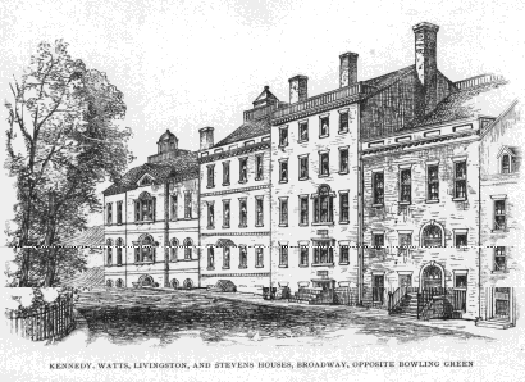 The absurdities of billiard,
shaving, and oyster "parlors," haircutting, tailor, bootmaking,
and fashion "emporiums," "anatomical" haircutting
and bootmaking, or "gentlemen's and ladies' diningrooms,"
on West or South Street, in the condemned pilothouse of an old steamer,
were unknown. I, in candor, however, may have to acknowledge to one or
two "merchant" tailors, but not like too many of a late day,
occupying small and confined apartments, with a very narrow scope of custom,
restricted more to mending than making. Pipesmoking (other than in common
clay pipes by laborers) was also unknown.
The absurdities of billiard,
shaving, and oyster "parlors," haircutting, tailor, bootmaking,
and fashion "emporiums," "anatomical" haircutting
and bootmaking, or "gentlemen's and ladies' diningrooms,"
on West or South Street, in the condemned pilothouse of an old steamer,
were unknown. I, in candor, however, may have to acknowledge to one or
two "merchant" tailors, but not like too many of a late day,
occupying small and confined apartments, with a very narrow scope of custom,
restricted more to mending than making. Pipesmoking (other than in common
clay pipes by laborers) was also unknown.
For spirituous drinks, in most cases, but three cents per glass was
charged; for ale, two or three cents; tobacco was three cents a paper;
the habit of chewing tobacco was then far more common than now. Imported
Havana cigars of the best quality could be bought for three cents, or five
for a shilling (12-1/2 cents), and, strange as it may now appear, young
men carried them in their hats, for it is to be borne in mind that cigarcases
were a rarity, and that within hats there was purselike diaphragm
lining, well designed to retain a handful of cigars, a handkerchief, or
a pair of gloves.
The fractional currency, in this and all the States at this period,
was very generally the Spanish coins of 25, 12-1/2, and 6-1/4 cents, and
they were denominated in the several States as follows: In New England,
Kentucky, and Tennessee the dollar was divided into six shillings, and
the coins were termed quarters, ninepence, and fourpence ha'penny. In this
State, Ohio, and Michigan the dollar was divided into eight shillings,
and the coins were termed sixpence, one shilling, and two shillings, according
to value. In New Jersey, Pennsylvania, Delaware, and Maryland the dollar
was divided into seven shillings and sixpence, and the divisions were termed
quarters, elevens, and fips; in South Carolina and Georgia, into four shillings
and eightpence, and the divisions were known as quarters, bits, and picayunes.
In consequence of the derangement of the currency by the war with Great
Britain, and the failure of many country banks, provisions were scarce
and dear: milk, 12-1/2 cents per quart; flour, $15 per barrel; and, a year
later, butter, beef, lard, pork, and potatoes were imported from Belfast.
Perhaps I should here remark that there was a numerous class of caterers
to the juvenile or junior tastes of the public that has wholly retired
from operation. Their specialty was to disperse mead, spruce beer, cakes,
and ginger pop; their locale was almost universally designated by
a sign, on which, for the mead and beer, was delineated a bottle with a
stream of liquor pouring from it into a tumbler at its side, with a uniformity
of outline and of curve that would have done credit to a geometrical draughtsman.
The ginger pop was designated In a very different manner, being totally
devoid of any illustration of convenience or economy inasmuch as two
men were portrayed as fulfilling the regulations of a duel, being placed
opposite to each other and each extending a bottle, from which emanated
a stream of liquor propelling a cork, which was as the bullet of a pistol.
New York at this date contained but two billiard. rooms, one in the
Washington Hall, the other in the Cafe Francais in Warren Street
near Broadway. American whiskey was not known as a general drink, and mint
juleps were only heard of as a mixture said to be taken by people in the
Southern States as a preventive against malaria. Rhine wines were unfamiliar,
and the use of champagne in either public or private houses was very rare.
The employment of ice for any purpose but for making icecream was
unknown. Families used an enclosed structure called a "safe,"
with woven wire sides and ends, admitting air and excluding flies (Crotonbugs
did not then exist), and on these alone they depended for preservation
of meats, milk, etc. Even the icecream (water ices were unheard of)
was furnished only by Mrs. Usher, in Broadway, where the New York Hotel
lately stood; and by John H. Contoit of the New York Garden, in
1801 at 39 Greenwich Street, in 1802 at 253 Broadway, and in 1806, and
for many years after, at 355 Broadway, between Leonard and Franklin streets.
The customary accommodations of these resorts were confined to rows of
open apartments, termed boxes, whitewashed or greenpainted, with a
plain bare table running through their centre, with a bare board seat on
each side, capable of seating two persons, lighted, that is, essayed to
be, by a dimly burning wick, floating in oil on a stand outside the entrance;
colored waiters with their labelled numbers displayed in front, expressing,
emphasizing, and displaying themselves in a manner known only to their
race, and a
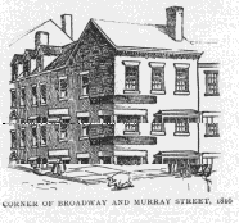 billoffare comprising
ice cream (vanilla, lemon, or straw berry, if in season), pound cake and
lemonade, with the exception that, at Contoit's you could be served with
a glass of veritable claret, and, if I recollect right, one of cognac
too. Milk was borne in tin cans suspended from the carriers, shoulders,-frequently
women,-and was supplied from cows within the city limits or contiguous
shores of Long Island and New Jersey. As there were no railroads or night
passages of river steamboats, no other sources existed from which milk
could be obtained. Milk wagons, "Orange County" milk and milk
bottles, and freshened or fortified milk, were equally unknown. There were
many cows which roamed the streets in the day and were stabled at night.
The slaughtering of animals for the markets was wholly done by individual
butchers on their premises in different parts of the city, the blood and
offal being carried to the river and deposited there. Gentlemen went to
market, and in default of express companies, messengers, etc., often carried
home a turkey, chicken, or a leg of lamb. The public authorities gave annually
a prize to the farmer who submitted to them the best sample of butter of
his production.
billoffare comprising
ice cream (vanilla, lemon, or straw berry, if in season), pound cake and
lemonade, with the exception that, at Contoit's you could be served with
a glass of veritable claret, and, if I recollect right, one of cognac
too. Milk was borne in tin cans suspended from the carriers, shoulders,-frequently
women,-and was supplied from cows within the city limits or contiguous
shores of Long Island and New Jersey. As there were no railroads or night
passages of river steamboats, no other sources existed from which milk
could be obtained. Milk wagons, "Orange County" milk and milk
bottles, and freshened or fortified milk, were equally unknown. There were
many cows which roamed the streets in the day and were stabled at night.
The slaughtering of animals for the markets was wholly done by individual
butchers on their premises in different parts of the city, the blood and
offal being carried to the river and deposited there. Gentlemen went to
market, and in default of express companies, messengers, etc., often carried
home a turkey, chicken, or a leg of lamb. The public authorities gave annually
a prize to the farmer who submitted to them the best sample of butter of
his production.
Canned vegetables and fruits were also unknown; hence, when their season
passed they passed, and as railways and interstate steamboat lines did
not exist, we did not receive the early fruits of the South or the game
of the North and West. A grocer's store of the time was as unlike one of
this day as if it was that of another line of business, there being a display
neither of bottled nor canned articles, fancy cakes, biscuits, etc., in
boxes. There were only two leading grocers of the Park & Tilford grade
of a later period-Richard Buloid at 129 Broadway and James Geery at 119
Mulberry, corner of Bayard Street, who was widely known for the excellence
of his teas. Mr. Richard Williamson, one of this class, appeared later
(1825, at 85 Maiden Lane).
The drive for gentlemen and others who drove out of an afternoon was
limited on the East side to Cato's (Fifty-Fourth Street and Second Avenue),
a wellknown resort, -see page 63,-where imported Havanas were sold,
five for a shilling (12-1/2 cents), and pure brandy at sixpence (6-1/4
cents) per glass-and for many years previous, and later, even down to 1830.
Love Lane, before mentioned, was the resort on Saturday afternoons of cartmen,
fish and oyster venders, etc., where their horses and those of others of
a like grade were raced for such entrance stakes or wagers as were mutually
agreed upon. The public racecourse was on Hempstead Plains, and known
as the New Market. The principal or noted restaurants were De Cousse's,
in Reade Street, under Washington Hall; Ainslie's in Broadway, between
Duane and Anthony
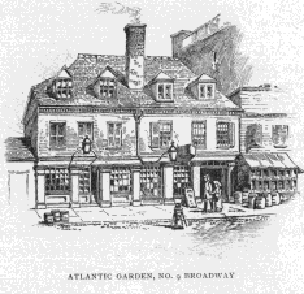
streets; and Lovejoy's, Broadway, corner of Anthony Street (Worth).
Sunday excursions on steamboats, etc., were unknown. It was only at a later
day, or about 1820, that the "Green" and river walk at Hoboken
became a general afternoon resort.
The Turtle Club, afterward known as the Hoboken Turtle Club, was in
existence; notices of its meetings were announced as dividends of twenty
or twentyfive per cent., and termed spoon exercise. Also the Krout
Club, which later was presided over by a Grand Krout, who once in a year
was declared to have nodded, thereby indicating his assent to a meeting,
which was opened at nine in the morning, and continued until late at night;
at the dinner, smoked geese, "ringlets,, (sausages), and sourcrout
were the pieces of resistance. The symbol of the place of meeting was a
cabbage on a pole. Members of the club were termed cabbageheads, and
a death or absence was termed wilting.
On the eve of Fourth of July,
or Independence Day, booths were erected around the City Hall Park, and
roast pig, eggnog, cider, and spruce beer were temptingly displayed. On
the following day the militia formed at the Battery, paraded up Broadway
to the City Hall, where it was reviewed by the Mayor and Aldermen, and
after executing a feu de joie was dismissed. The various civic societies
met, formed in line, and marched through some of the principal streets;
the Tammany Society, by right of seniority, being assigned to the head
of the column. Evacuation Day, or the anniversary of the evacuation of
the city by the British, was very generally observed at this time. Horse,
foot, and artillery, together with the veterans of the war, paraded. Salutes
were fired in the morning, and public dinners occupied the evening. My
readers are aware that this day never passes now without at least some
slight observance in New York, and many of them will remember the elaborate
preparations made
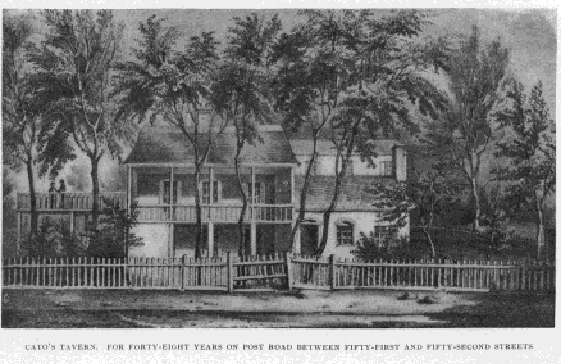 for
celebration of the Centennial Anniversary in 1883, and the furious storm
of that day, which ruined a pageant that, with fine weather, would have
been the most superb ever witnessed by the city up to that time.
for
celebration of the Centennial Anniversary in 1883, and the furious storm
of that day, which ruined a pageant that, with fine weather, would have
been the most superb ever witnessed by the city up to that time.
The chief fuel of the time, and for many years after, was wood, sold
by the load from the vessels that brought it to the city, each load measured
by a City inspector. It was in full length (four feet), delivered in the
street in front of buildings or residences, where it was sawed by wood
sawyers (colored) in two lengths only, and occasionally split. Steam sawing
and splitting mills were not introduced until very many years after, and
if woodyards existed, I do not recollect one. Coal was very little
in use for domestic purposes except in parlor grates; in this vicinity
it was commercially termed Liverpool or Newcastle, from the names of the
ports from which it was shipped, and as it all came from abroad was generally
known as "sea coal", a title which it bore long after the mines
of Virginia and Maryland were opened, and which is heard in the speech
of oldfashioned persons even to this day. Anthracite was virtually
unknown. Some of it had been mined in Rhode Island under management of
the Rhode Island Coal Co. of 42 Wall and 47 Canal streets, which distributed
samples of it among a few of our wellknown citizens to test and report
thereon. One of them, Martin S. Wilkins, of 53 White Street, upon being
applied to for his response replied:
"I am willing to certify that, under favorable circumstances this
coal is capable of ignition, and I am willing further to certify that,
if Rhode Island is underlaid with such coal, then, at the general conflagration
which our ministers predict, it will be the last place to burn."
Furnaces, hallstoves, and the airtight stoves for bedrooms
were absent from the houses of the period; and in severe weather the best
of these houses were much less comfortable than many stables of this day.
Warming pans for beds were all but a necessity for elderly persons, bedrooms
being so cold that washing in the morning often could be done only after
first breaking the ice in the pitcher. The facilities for procuring a light
for fire at the present time are so widely different from and so much more
convenient than methods at that time, that the question has been very frequently
asked, How did we put up with such inconvenience? The only reliable artificial
method was that of the construction of a tinderbox, filled with tinder
of wellscorched rag, a flint, and a suitable piece of steel; or by
the rapid operation of a steel wheel, rotated by drawing a long cord previously
wound around its axis; to the face of this was applied a flint, the sparks
elicited by it falling upon the tinder, to which, when ignited, a sulphur
or bituminous match, as it was termed, was applied and lighted. The French
phosphoric matches, borne in a case with a vial of a phosphoric mixture
and twentyfive matches, price fifty cents, were altogether unreliable.
As a consequence of the difficulty attendant upon these inconvenient methods,
when a light was required at night, as in the rooms of sick persons, city
fireengine houses, etc., tapers in oil were maintained lighted.
The doors of domestic bedrooms were seldom locked at night by the occupants,
and the entrances to dwellings in the summer season were held to be sufficiently
secured, in the daytime, by the closing of an outer blinddoor. Housebells
were but very little used; in a few cases there were bells for the streetdoor
and the parlors, but generally the streetdoor was furnished with a
knocker, and bedrooms were wholly without bells. The very convenient custom
of residents having their names on an engraved plate on their frontdoors
was in general observance; it is to be regretted that it has been abandoned.
Domestic service at this period and long afterward, or until the introduction
of illuminating gas, hotair furnaces, and
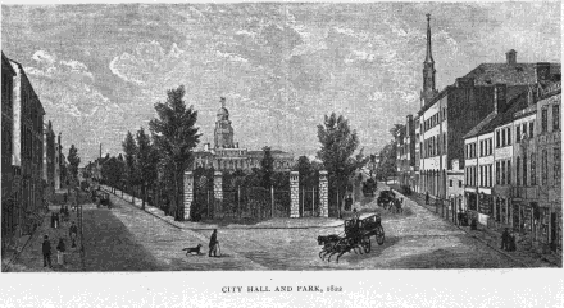 Croton water, and the construction
of street sewers, was much more onerous than at this time. Oil lamps required
trimming and filling; candlesticks, the fronts of gratefenders, and frequently
the shovel and tongs of brass, were to be cleaned; wood and coal to be
brought from the cellar to all the fires, and the absence of hallstoves
rendered fires necessary in all sittingrooms. All water required for
the kitchen, or bedrooms, or for baths, was drawn from the nearest streetpump,
and all refuse water and slops were carried out to the street and emptied
into the gutter; the brass ornaments on the iron railings of the stoop,
the doorplate, and the knocker, called for cleaning; added to which,
the street, for half its width in front of each dwelling, was to be swept
twice a week. A prudent person would hesitate before asking a third of
the like services of a domestic of late years. A full beard, or even an
imperial or goatee, was unknown, except when a native of an Eastern country
would appear with the former, and as such an exhibition was a rarity, the
wearer would be an object of general attention, even to being followed
by a number of boys.
Croton water, and the construction
of street sewers, was much more onerous than at this time. Oil lamps required
trimming and filling; candlesticks, the fronts of gratefenders, and frequently
the shovel and tongs of brass, were to be cleaned; wood and coal to be
brought from the cellar to all the fires, and the absence of hallstoves
rendered fires necessary in all sittingrooms. All water required for
the kitchen, or bedrooms, or for baths, was drawn from the nearest streetpump,
and all refuse water and slops were carried out to the street and emptied
into the gutter; the brass ornaments on the iron railings of the stoop,
the doorplate, and the knocker, called for cleaning; added to which,
the street, for half its width in front of each dwelling, was to be swept
twice a week. A prudent person would hesitate before asking a third of
the like services of a domestic of late years. A full beard, or even an
imperial or goatee, was unknown, except when a native of an Eastern country
would appear with the former, and as such an exhibition was a rarity, the
wearer would be an object of general attention, even to being followed
by a number of boys.
The city at this time offered but few and restricted attractions to
a foreigner, but from the convenience consequent upon its restricted area,
the simple wants of its citizens, and the dependence upon the comforts
of home enlivened by evening visits and gatherings then truly social, it
was a very desirable place of residence; more so than it ever can be
again, except to those who profit by its metropolitan character. In
the absence of clubhouses, theatres, and other places of amusement, and
of late dinners, the houses of New York were more strictly homes than at
present. Evening visiting was general, and in the winter season quilting
parties and entertainments with hickory nuts, apples, new cider, and doughnuts,
were the custom, occasionally varied by whiskeypunch-not that of the present
day, sweetened with a questionable sugar, and with a slice of lemonpeel,
but both sweetened and soured with currant or guava jelly. Cards were much
used; and the elders played whist while the younger part of the company
indulged in round games. In evening gatherings confined to the young, doughnuts,
crullers, apples, hickory nuts, and cider were also served, and the boiling
and pulling of molasses candy were accepted elements of fun and frolic.
The family tables were very simply supplied, and the hours of meals were
regular; breakfast at eight, dinner, which very generally consisted of
but one course, at from two to three, and supper at from six to seven o'clock.
On the first or parlor floors of the houses were two pantries, in which
the table china, glasses, and company teaset were placed, together
with the fruit preserves, which had been made by the mistress in person
at the kitchen fire There were then no canned fruits, etc., and so imperative
was the duty upon all provident housekeepers to make these preserves for
the coming season and year that such of the few as were visiting in the
country were accustomed to hurry to the city early in September to provide
them, as well as the required sausages and headcheese. In all diningrooms
there was a sideboard, a large piece of furniture in which were held the
knives, forks, spoons, etc., of the table; it also was the repository of
liquors of various kinds, and at all evening visits, guests, without exception,
were invited to partake of a friendly or a parting glass, usually of brandy.
It was not considered at all necessary that the counters of banks and
bankers should be shut in by wire nets or iron gratings, since sneakthieves
and the like were seldom heard of. (clerks never ventured to wear their
hats within the precincts of their employment, neither did they or other
young men of the day fail to remove them on entering an office or dwelling,
heu mutatus. The duties of the junior clerk of that time were very
different from those of the present day, both in character and extent.
He was required to sweep the offices, to go to the Postoffice, both
for letters and to post them (there was but one office; stations and lamppost
boxes were unknown), and, in many employments, he swept the sidewalk and
the street to half its width, in front of the store in which he was employed.
Readers of the present day may be surprised to be told that at the period
noted, and for many years after, blottingpaper, as a convenience in
writing, was measurably unknown. Metallic sand, writing sand as it was
termed, was used for absorbing ink, and a sandbox was nearly as requisite
to a writingdesk as a pen and ink. Copying presses did not exist,
and as a consequence the junior clerk in a counting house had not only
to copy all outgoing letters, but, in case of those sent abroad, he had
to make duplicates to be sent by the next packet; but offices were opened
before nine o'clock in the morning, and kept open until dark; and on packet
days, until the correspondence was finished, however late. A carpeted office
was a rarity, while its furniture was of a very plain character. In illustration
of the sentiments then entertained regarding what was deemed unnecessary
expense in offices, and the evil effects of such extravagance, so late
as 1826 a member of an importing house in this city called at the office
of a house that had just failed, regarding the condition of his claim against
it. On his return he reported to his senior partner that he was not surprised
at the failure, as he found a large open coal fire in their
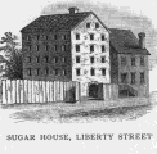
office, when it was so hot he had to ask to have the window opened,
and the floor was carpeted; such extravagance as that could but, in his
opinion, lead to bankruptcy. So great is the difference between the earlier
portion of the century and these its closing days, when the highest luxury
of business appointments is often vaunted as a sign of prosperity, and,
it may almost be said, appealed to as a basis of credit.
There was a feature in social requirements of that day, prejudices as
some would say, that was as decided as it may be incredible to many persons
of the present time, and it is one so wholly opposed to existing practices
that I would not endanger the estimate of my veracity by referring to it,
but that I have frequently mentioned it when in presence of persons of
a like age with mine, and in every instance my statement has been endorsed,
viz.: no man who was known to smoke a cigar in the streets or at his office
in business hours, could have procured a discount at any bank in the city.
There was but one Exchange and that at the Tontine Coffee House (see
page 48); the hour of meeting was 1 PM and the general dinnerhour
of merchants and professional men was from two to three; after which they
returned to their countingrooms or offices and remained until the
close of daylight.
The windows of stores and shops were closed tightly at night by shutters,
and as the street oillamps were very infrequent, the streets were
so very indifferently lighted, compared to the present illumination by
electricity, gaslamps, and the gaslights in stores with unobstructed
open plateglass windows, that they would not now be held to be lighted
at all; and besides, during the period of a quarter and a threequarter
moon, the lamps were not lighted, whether the moon was obscured or not,
as the lighting of them was determined by the almanac.
At this time the apprentice system was in full operation; boys desiring
to acquire a trade were apprenticed to the employer until they were twentyone
years of age, and in most cases, as of old, they resided in the house of
the employer and consequently were subjected to his discipline, not only
in deportment but as to hours of retiring and other habits of life. Workmen,
that is, all artisans and laborers, whether men or apprentices, were employed
and paid according to the work performed by them, and the estimate of their
capacity. Employers engaged or discharged whomsoever they saw fit to, and
although there were not any societies that assumed to fix the wages of
workmen, the rate of wages for the different grades of work and classes
of workmen was well known and as well observed and conceded. Thus, an idle,
irregular, and unmarried man, who would be frequently absent when most
wanted, was not paid an equal amount with a steady man with a family to
provide for.
A young gentleman of this city, son of a wellknown and respectable
resident, returned from brief travel in Europe with his upper lip adorned
with a moustache. This was the very first display of one by an American
in this city, and it was so observedly singular and exceptional that it
occasioned much comment and criticism. So great was this departure from
the custom of our people that it was not until 1836, and then only by progressive
invasion upon the general prejudice, that such exhibitions, as they were
termed, were at all assented to; even so late as 1850, I have heard moustaches
termed "monstrous" by persons of taste, culture, and sober judgment.
The law of imprisonment for debt was in force at this time, and the
jail for this noncriminal class becoming overcrowded, certain of them
were allowed freedom within fixed limits outside of the jail, or "
jail liberties,', as they were termed, which were then confined to the
territory below Anthony on the north and west sides and somewhere about
its adjoining street on the east side; notices of the limits being painted
on the corners.
Church service, even, has undergone a marked change. At 9 A.M. on a
Sunday, the church bells were rung, probably for the purpose of reminding
the citizens of the day, and again at 10 and 10.30 and at 2 and 7 P.M.
for the afternoon and evening services. The choirs, with the exception
of that of Grace Church, where Miss Ellen Gillingham sang, were composed
of volunteers from the congregation, led by a preceptor, or, as in the
Episcopal Churches, by the clerk. In the Presbyterian and other Reformed
Churches the length of the morning prayer and of the sermon was a terror
to juveniles, and irksome to all others, however much they feigned to think
otherwise; even the doxologies to a psalm partook of the general extension.
Sunday dinners in families very generally were but cold collations. The
streets were measurably void of passing vehicles, yet, that the church
services might not be disturbed, it was ordered that during the hours of
Divine worship chains should be placed across the streets bounding a church.
This ordinance, how ever, was so generally opposed that, about the year
1828, it was universally disregarded.
Men's and boys, clothing and the manner of procuring it was very different
from the modes of this time. The street dress of gentlemen consisted of
a blue coat with gilt buttons, white or buff waistcoat with gold buttons
(I retain a set), kneebreeches of buckskin, buckles, and top boots.
Spencers, or cloth jackets, in cold weather were often worn over coats,
and for outer wear "boxcoats" as they were termed, that
is, greatcoats with from one to seven or more capes buttoned on. Wellington
boots (introduced and so termed after the Battle of Waterloo), cut high
with tassels at the tops, prevailed; they were worn outside of the pantaloons.
Shirt collars were very full, false collars and wristbands or cuffs were
unimagined; black or white cravats, none other- not the ribbons, etc.,
of this day-but stiffened with a "pudding" of wool, horsehair,
or hog's bristles; to the bosoms of the shirts were attached low down pleated
frills. Black clothing was never worn except for mourning or by clergymen.
The full dress of gentlemen was dark dress coat with rolling collar
running down low in front, shortwaisted white waistcoat, frilled bosom
to shirt, kneebreeches with gold buckles, black silk stockings and
pumps; watchchain and seal displayed pendent from a fob in the breeches.
The walking dress of ladies, and for some years after, was essentially
alike to the illustration here given, with the variation of Leghorn bonnets
or flats, as they were termed, which were imported, one entire with an
additional crown or body piece, in order that by cutting off onehalf
the rim of the full one with the loose crownpiece sewed to it, two full
bonnets were made. long ribbons were tied in a bow, hanging down from the
waist behind, near the ground; and on the forehead many wore at the sides
false hair, fashioned alike to short drapery and termed frizettes, and
all wore high and broad tortoiseshell combs. Fur muffs were of the
full dimensions
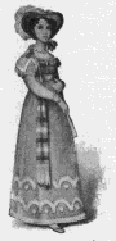
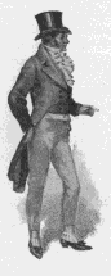 of
a tengallon keg, and were frequently used in shopping as receptacles,
as well as for the hands.
of
a tengallon keg, and were frequently used in shopping as receptacles,
as well as for the hands.
Boys' clothing was made by seamstresses from the discarded garments
of father or elder brothers; their mittens for cold weather were knitted
by the female members of the house, and as to military or like uniforms
they were confined solely to the scholars of two French schools.
In the outer adornment of both men and women, the custom and fashion
of the day were materially at variance with that of the present here illustrated
as to men, and as to women I am regretfully at a loss for a description;
but I know that one article of their underwear, now held to be indispensable
was not worn by ladies at all until many years after. There were at this
time but two "slop" tailors, as they were termed, and they in
Cherry Street; that is, stores where one could purchase an outfit of garments,
designed for the convenience of seamen, boatmen, and longshoremen. The
descendant of one of these dealers now occupies a leading position in the
clothing business in the upper part of Broadway. Clothiers or "merchant
tailors" were unknown; as men in all parts of the country, excepting
those who dealt with the slop tailors referred to, obtained their clothing
directly from tailors, the absurd prefix of "merchant" was then
wanting.
Children's sports were conducted with a measure of simplicity far removed
from the elaborate provision of the " sporting goods " shops
which are now considered necessary. If a baseball was required, the
boy of 1816 founded it with a bit of cork, or, if he were singularly fortunate,
with some shreds of indiarubber; then it was wound with yarn from
a ravelled stocking, and some feminine member of his family covered it
with patches from a soiled glove. Our skates were a primitive instrument,
compared with those of a later period. The blades were very thin, and generally
of iron, involving the frequent filing of the gutters to keep them sufficiently
sharp for safety; there were heel and toe straps, without screws for the
heel of the shoe; and as a result, we had to draw all the straps so tight,
to maintain the skates in position, that the necessary circulation of the
blood in our feet was arrested, and we were frequently tortured with pain
and cold. The modern effective mechanical appliances by which they are
now fastened with a single motion were not introduced until very many years
later. For a baseball bat, if anything better than a casual flat or
round stick was required, negotiation had to be entered into with some
woodturner to induce him to lay aside his regular work to produce
one. Then, if the boy could manage to be present at the time of the important
operation, he witnessed it with absorbed interest and bore away with him
the new creation with gratifying feelings of pride and possession. Yet
we did play ball, skate, etc., and enjoyed ourselves; although in the absence
of stages
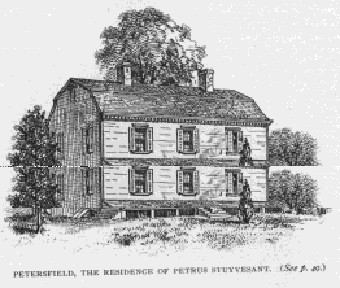 or any means of public
conveyance, we walked from below Canal Street, the then limit of the city,
to Stuyvesant's meadow, the Sunfish pond, or Cedar Creek, and were satisfied.
or any means of public
conveyance, we walked from below Canal Street, the then limit of the city,
to Stuyvesant's meadow, the Sunfish pond, or Cedar Creek, and were satisfied.
Christmas was very slightly observed as a general holiday at the time
of which I write, and Christmas shopping and Christmas presents, except
those of " Santa Claus " for children, scarcely existed. New
Year's Day was the popular winter holiday, the very old custom of paying
New Year's visits being universal, as indeed it continued to be until perhaps
twenty years ago (1874), There is no old New Yorker who does not regret
the abandonment of this timehonored custom, however much it may be
required by changed conditions; especially by the extension of the town
and resulting enlargement of men's acquaintance and visiting lists.
Notable events in this year were the completion of Macomb's Dam, at
the site of the present bridge, which soon became a justly favorite spot
for fishing, the opening of Eighth and Ninth avenues and First and Thirteenth
streets, the extension of Hudson Street from Laight Street to Greenwich
Avenue, and of Franklin Street. In this year was organized, under the presidency
of Cadwallader D. Colden, the Manumission Society to advance the freedom
of slaves at the South. On July 5 there was frost in many localities of
the island.
At No. 80 William Street a Frenchman of the name of Francis Adonis,
who displayed a sign reading, "Hairdresser from Paris," and whose
customers were principally French refugees, had been a notorious character,
from the circumstance that from the time of his advent here until the restoration
of a Bourbon in the person of Louis XVIII. he, when in public, bore his
hat under one arm, in pursuance of a declaration that he would never wear
one until a Bourbon was restored to the French
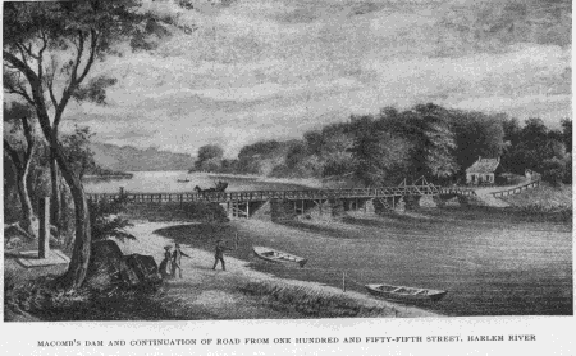 throne. He claimed to have
been the hairdresser of Louis XVI.
throne. He claimed to have
been the hairdresser of Louis XVI.
Columbia College, instituted 1753 and located in an area bounded by
Murray, Church, the south line of Robinson Street (Park Place) not then
opened through and Chapel (College Place). was removed in 1857 to corner
of Madison Avenue and Fortyninth Street.
The students of the college, prior to its removal, alike to the students
of other colleges, did not entertain or practice gymnastics as an element
of college education. Of those of Columbia I write advisedly-they were
not members of a boat club, baseball, or football team.
On Saturday afternoons, in the fall of the year, a few students would
meet in the " hollow " on the Battery, and play an irregular
game of football, generally without
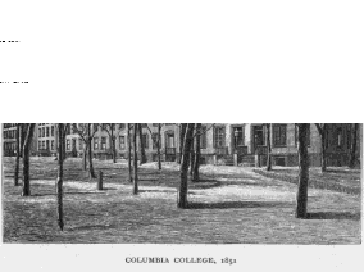 teams or "sides,"
as they were then termed; a mere desultory engagement.
teams or "sides,"
as they were then termed; a mere desultory engagement.
As this "hollow " was the locale of baseball,
"marbles," etc., and as it has long since been obliterated, and
in its existence was the favorite resort of schoolboys and all others living
in the lower part of the city, it is worthy of record. Thus: it was very
nearly the entire area bounded by Whitehall and State Streets, the sea
wall line, and a line about two hundred feet to the west; it was of an
uniform grade, fully five feet below that of the street, it was nearly
as uniform in depth, and as regular in its boundary as a dish.
The American Museum of John Scudder, first opened in 1810 at 21 Chatham
Street, removed in this year to the west end of the building of the New
York Institution, on Chambers Street.
The block bounded by Centre, Leonard, Elm, and Franklin streets was
occupied by the city, and known as the Corporation Yard, where the fireengine
and ladder trucks were built and equipped, and light work was done connected
with repairs of public buildings, coffins for paupers, etc. The American
Bible Society was organized in May of this year, and its first publication
was issued, in 1819, from No. 20 Slote Lane (not nonexisting). David Bruce,
from Scotland in 1793, first introduced stereotyping. Later, he was the
senior member of the firm of David & George Bruce.
At this period there were but ten wards in the city. Arson was punishable
with death. Slavery existed, both slaves and their "times" were
advertised in daily papers.
The Rt. Rev. Dr. Benjamin Moore, second Bishop of New York, died in
February of this year, being succeeded in office by his coadjutor, John
Henry Hobart, who displayed distinguished ability in his administration
during the next fifteen years.
The names of the following streets were changed previous to the date
of these reminiscences, but were frequently referred to under their original
names.
OLD Crown, Dock,
Duke, . Dyes, Fair,
Liberty Street
Pearl, between Broad and Hanover Square.
South William , Dey..
Fulton, between Broad way and Cliff
George, . . Spruce.
King George, William, between Frank
fort and Pearl.
King, . . . Pine.
OLD
Little Dock,
Little Queen
Magazine,
Partition,
Queen,
NEW
South, between Whitehall
and Old Slip.
Cedar.
Part of Pearl.
Fulton, between Broad
way and North River.
Princess, . Beaver, between Broad
and William
. Pearl, between Wall and Broadway
Park Place
James.
Robinson,
St. James,
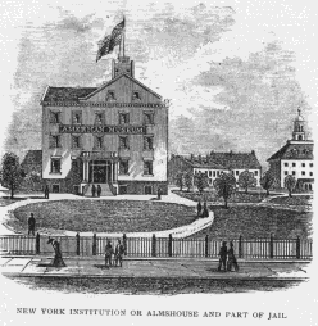
 The absurdities of billiard,
shaving, and oyster "parlors," haircutting, tailor, bootmaking,
and fashion "emporiums," "anatomical" haircutting
and bootmaking, or "gentlemen's and ladies' diningrooms,"
on West or South Street, in the condemned pilothouse of an old steamer,
were unknown. I, in candor, however, may have to acknowledge to one or
two "merchant" tailors, but not like too many of a late day,
occupying small and confined apartments, with a very narrow scope of custom,
restricted more to mending than making. Pipesmoking (other than in common
clay pipes by laborers) was also unknown.
The absurdities of billiard,
shaving, and oyster "parlors," haircutting, tailor, bootmaking,
and fashion "emporiums," "anatomical" haircutting
and bootmaking, or "gentlemen's and ladies' diningrooms,"
on West or South Street, in the condemned pilothouse of an old steamer,
were unknown. I, in candor, however, may have to acknowledge to one or
two "merchant" tailors, but not like too many of a late day,
occupying small and confined apartments, with a very narrow scope of custom,
restricted more to mending than making. Pipesmoking (other than in common
clay pipes by laborers) was also unknown. billoffare comprising
ice cream (vanilla, lemon, or straw berry, if in season), pound cake and
lemonade, with the exception that, at Contoit's you could be served with
a glass of veritable claret, and, if I recollect right, one of cognac
too. Milk was borne in tin cans suspended from the carriers, shoulders,-frequently
women,-and was supplied from cows within the city limits or contiguous
shores of Long Island and New Jersey. As there were no railroads or night
passages of river steamboats, no other sources existed from which milk
could be obtained. Milk wagons, "Orange County" milk and milk
bottles, and freshened or fortified milk, were equally unknown. There were
many cows which roamed the streets in the day and were stabled at night.
The slaughtering of animals for the markets was wholly done by individual
butchers on their premises in different parts of the city, the blood and
offal being carried to the river and deposited there. Gentlemen went to
market, and in default of express companies, messengers, etc., often carried
home a turkey, chicken, or a leg of lamb. The public authorities gave annually
a prize to the farmer who submitted to them the best sample of butter of
his production.
billoffare comprising
ice cream (vanilla, lemon, or straw berry, if in season), pound cake and
lemonade, with the exception that, at Contoit's you could be served with
a glass of veritable claret, and, if I recollect right, one of cognac
too. Milk was borne in tin cans suspended from the carriers, shoulders,-frequently
women,-and was supplied from cows within the city limits or contiguous
shores of Long Island and New Jersey. As there were no railroads or night
passages of river steamboats, no other sources existed from which milk
could be obtained. Milk wagons, "Orange County" milk and milk
bottles, and freshened or fortified milk, were equally unknown. There were
many cows which roamed the streets in the day and were stabled at night.
The slaughtering of animals for the markets was wholly done by individual
butchers on their premises in different parts of the city, the blood and
offal being carried to the river and deposited there. Gentlemen went to
market, and in default of express companies, messengers, etc., often carried
home a turkey, chicken, or a leg of lamb. The public authorities gave annually
a prize to the farmer who submitted to them the best sample of butter of
his production.
 for
celebration of the Centennial Anniversary in 1883, and the furious storm
of that day, which ruined a pageant that, with fine weather, would have
been the most superb ever witnessed by the city up to that time.
for
celebration of the Centennial Anniversary in 1883, and the furious storm
of that day, which ruined a pageant that, with fine weather, would have
been the most superb ever witnessed by the city up to that time. Croton water, and the construction
of street sewers, was much more onerous than at this time. Oil lamps required
trimming and filling; candlesticks, the fronts of gratefenders, and frequently
the shovel and tongs of brass, were to be cleaned; wood and coal to be
brought from the cellar to all the fires, and the absence of hallstoves
rendered fires necessary in all sittingrooms. All water required for
the kitchen, or bedrooms, or for baths, was drawn from the nearest streetpump,
and all refuse water and slops were carried out to the street and emptied
into the gutter; the brass ornaments on the iron railings of the stoop,
the doorplate, and the knocker, called for cleaning; added to which,
the street, for half its width in front of each dwelling, was to be swept
twice a week. A prudent person would hesitate before asking a third of
the like services of a domestic of late years. A full beard, or even an
imperial or goatee, was unknown, except when a native of an Eastern country
would appear with the former, and as such an exhibition was a rarity, the
wearer would be an object of general attention, even to being followed
by a number of boys.
Croton water, and the construction
of street sewers, was much more onerous than at this time. Oil lamps required
trimming and filling; candlesticks, the fronts of gratefenders, and frequently
the shovel and tongs of brass, were to be cleaned; wood and coal to be
brought from the cellar to all the fires, and the absence of hallstoves
rendered fires necessary in all sittingrooms. All water required for
the kitchen, or bedrooms, or for baths, was drawn from the nearest streetpump,
and all refuse water and slops were carried out to the street and emptied
into the gutter; the brass ornaments on the iron railings of the stoop,
the doorplate, and the knocker, called for cleaning; added to which,
the street, for half its width in front of each dwelling, was to be swept
twice a week. A prudent person would hesitate before asking a third of
the like services of a domestic of late years. A full beard, or even an
imperial or goatee, was unknown, except when a native of an Eastern country
would appear with the former, and as such an exhibition was a rarity, the
wearer would be an object of general attention, even to being followed
by a number of boys. 

 of
a tengallon keg, and were frequently used in shopping as receptacles,
as well as for the hands.
of
a tengallon keg, and were frequently used in shopping as receptacles,
as well as for the hands. or any means of public
conveyance, we walked from below Canal Street, the then limit of the city,
to Stuyvesant's meadow, the Sunfish pond, or Cedar Creek, and were satisfied.
or any means of public
conveyance, we walked from below Canal Street, the then limit of the city,
to Stuyvesant's meadow, the Sunfish pond, or Cedar Creek, and were satisfied. throne. He claimed to have
been the hairdresser of Louis XVI.
throne. He claimed to have
been the hairdresser of Louis XVI. teams or "sides,"
as they were then termed; a mere desultory engagement.
teams or "sides,"
as they were then termed; a mere desultory engagement.